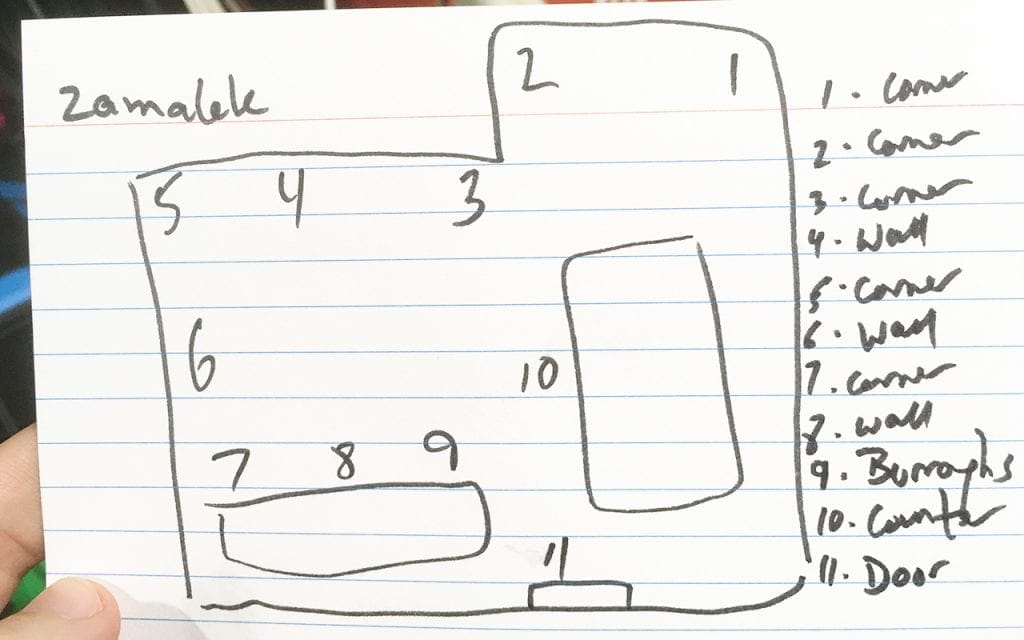Podcast: Download
Subscribe: Apple Podcasts | RSS
 Nothing could be easier than using a Memory Palace for studying.
Nothing could be easier than using a Memory Palace for studying.
Once you know how it works, that is. Unfortunately, many learners think they do, but have really only scratched the surface.
What is that surface understanding?
You may have heard that a Memory Palace (also called the method of loci) is a mental map of a familiar location, like your home or your school.
You then assign the information you need to remember to specific locations along a route through your chosen location.
These locations then help cue your mind so that the facts you want to remember come flooding back.
The problem is that this is only part of how the technique works. And even that explanation leads many people to use the technique incorrectly first.
Today we’re going to fix this problem by focusing on how the Memory Palace technique actually works, specifically for studying large amounts of complex information.
If you’re willing to learn the foundational skills first, you’ll be able to apply the technique to memorizing anything.
And I do mean anything. I have yet to see a topic or information category for which the Memory Palace technique cannot provide tremendous learning advantages.
How do I know? Well, I’ve memorized one of the most widely seen TEDx Talks about memory, used multiple Memory Palaces to complete my PhD, pass language exams, earn certifications and give epic demonstrations at meetings where I memorized the names of dozens of people within minutes.
I did that most recently during a real estate licensing certification course. Not only did I pass thanks to my combination of Memory Palaces with other study techniques.
But after seeing me recite the names of every student in the room, the teacher asked me to teach these techniques to the entire class. Which I did.
By the end of this guide, you’ll know exactly how to do the same with a special focus on building a Memory Palace Network to study faster, remember longer and walk into any exam with confidence.
Ready to learn from my experiences?
Let’s dive in!
Using a Memory Palace for Studying: 7 Tips to Memorize Anything Fast
As we go through these tips, please understand that the tips you’re about to encounter build upon one another.
And the first is non-negotiable because the Memory Palace technique is not a trick. It’s a formal practice that was perfected in the ancient world.
Here’s the Magnetic Memory Method approach to Memory Palaces in a nutshell before we get into the granular details:
- Select a familiar location and map out a clear route with distinct stations by drawing out your journey by hand.
- Organize the material you want to memorize before doing any encoding so that you’re sure about what you want to memorize.
- Assign fully “Magnetic” associations using a multi-sensory approach like the Magnetic Modes (a.k.a. KAVE COGS).
- Use Bridging Figures to maximize the alphabetical principle of the Magnetic Memory Method.
- Review with Recall Rehearsal, a structured form of active recall and spaced repetition.
- Refine your use of the technique through practice.
Whether you just want to remember simple things better or pass a major exam, the steps outlined above are the key to memorizing everything from simple facts to entire course syllabi.
Now let’s dig into the granular details.
One: Use Memory Palaces Correctly
I see so many students either struggling with or failing with mnemonics. Largely, this happens because they treat the Memory Palace technique as if it’s a combination safe or treasure house for “storing” information.
But as you can see in the video tutorial above, that’s not the way the technique works at all. It’s not a “set and forget it” approach to learning at all.
Since knowledge is power, it’s helpful to understand why people get this impression in the first place. Although you might think the idea of storing information in rooms might stem from the Sherlock Holmes approach to memory techniques, the idea of storing information in rooms is much older.
For one thing, that’s basically how St. Augustine described the technique.
As he wrote in his Confessions:
And I come to the fields and spacious palaces of my memory, where are the treasures of innumerable images, brought into it from things of all sorts perceived by the senses.
The problem with Augustine’s description is simple:
He makes it seem as if you just file information away as if Memory Palaces are the medieval equivalent of a hard drive.
No, no and a thousand times no.
In order to make the technique work, you want at the very least to add the elements of active recall.
Briefly, you need to do these three things within your Memory Palaces:
- Make sure all of your mnemonic imagery is personalized and include as much variety as possible.
- Don’t cheat when reviewing. Push your mind a little to call back the information.
- Use the Recall Rehearsal patterns that are central to the Magnetic Memory Method
Even though I’ve written about St. Augustine’s more useful ideas about memory at length, it’s tragic that he misses this final point about Recall Rehearsal.
It’s essential. You cannot just encode information and expect memories to form.
Rather, you need to recall the information as if you’re “reading” it from the walls of your Memory Palaces, ideally using the different patterns the Memory Palace allows for, including backwards.
And if you think backwards is a stretch that doesn’t apply to you, Matteo Ricci would surely beg to differ.

Two: Take Care When Assigning Your Memory Palaces
Unfortunately, many people follow the advice of people who don’t actually use Memory Palaces for studying.
Look, the memory competitors are impressive. I’ve interviewed many of them on my podcast, including Tony Buzan who created the initial memory competitions.
The problem is that the vast majority of memory competitors have short term goals.
Those who have taken on larger learning projects for things like medical school and language learning include Alex Mullen, Nelson Dellis and Joshua Foer. They all put a lot of care into how they select and use locations for their Memory Palace efforts. And you should too.
So what are some quick tips to follow? From what I’ve seen, here’s what matters most:
- Simple and small journeys work best, even if you wind up needing a lot of Memory Palaces.
- Start at the “dead end” instead of at the door. That way you’re leading yourself to an exit and can add more loci later if needed.
- Don’t worry about “connecting” one Memory Palace to another. This usually wastes time and can be avoided by using Memory Palaces correctly.
- Only worry about reusing Memory Palaces after you can successfully use at least 10-20 with predictable positive results.
- Consider using the alphabetical method so you can link Memory Palaces with Bridging Figures. This technique is not always helpful, but you’ll be glad you’ve got it when you need it.
Three: Organize the Information Before You Start Encoding It
The Memory Palace technique is generally quite easy for most people who take it seriously.
But what isn’t always so easy is figuring out what main points you need to memorize.
I suggest you get started small and use the technique I share in how to memorize a textbook.
This process will help you start recognizing what counts as a main point faster. And the more you practice how you’re going to place those points in your Memory Palaces gives you the personalization experience that active recall requires in order for you to master these techniques for memory and studying.
It’s really important not to overlook the organization step. As another great memory master from the past named Thomas Aquinas put it so clearly in his Summa Theologica: “the mind favors organization.”

Four: Get Past the Need For Mnemonic Examples A.S.A.P.
I’m sometimes criticized for not giving people enough mnemonic examples in my books and courses.
First of all, this is not true. If anything, I’ve given way too many. There are well over 300 in The Victorious Mind alone.
Secondly, the legendary Harry Lorayne says the same thing in Ageless Memory. He’s probably the world’s leading memory expert, so if you can’t take my word for it, you can take his. Even Tony Buzan said Lorayne was the best of the best.
The question is… why is my suggestion that you stop seeking so many mnemonic examples essential to your success?
As pointed out in the Rhetorica ad Herennium, even students back in 90 B.C.E. were weakened by receiving too many mnemonic examples.
This is because the only true way to make mnemonics that stick is to come up with your own.
The sooner you start doing that, the sooner you’ll be able to apply them and remember what you study and read. You’ll also be fully maximizing your use of how your memory really works.
Five: Practice Encoding At Calm Hours (P.E.A.C.H.)
So many people try to “squeeze” their learning in.
Yes, cramming can work once in a while. But it ultimately interferes with effective chunking using the best possible memory hacks.
Here’s how to practice encoding at calm hours:
- Don’t reach for a phone or turn on a computer first thing in the morning. Use the time to meditate and then study.
- Sit with your book or flashcards in a quiet study area.
- Bring the best possible Memory Palace to mind.
- Use your training with mnemonic images to bring the best possible associations to mind.
- Place your mnemonic images in your Memory Palace in the way that makes most sense to you.
- Test in intervals throughout the day, ideally in a Memory Journal.
- Use Recall Rehearsal while testing (a.k.a. spaced repetition)
Moreover, it’s helpful to know your goal. Literally say it out loud: “I am studying history and using my history Memory Palace.”
Then, prepare everything you need the night before. That way, when you show up in the morning, you can dive right in.
If you have multiple topics to study, instead of feeling overwhelmed or getting stuck in decision anxiety, here’s a little tip:
Check in with your body. See if you intuitively have a felt preference. Then go with that.
Or you can do an exercise I learned in The Wise Advocate. Ask which study topic makes you feel more expansive and go with that (as opposed to feeling limited or constrained).
Decision metrics like these can help you loosen up and just get moving. You can also add the relaxation and breathing exercises discussed in The Victorious Mind.

Six: Treat Your Memory Practice like a Profession
To be honest, the idea of memory techniques “for” students really doesn’t make that much sense to me.
I suggest learners of all ages think of themselves as entrepreneurs, or at least investors.
Yes, you’re learning and people who learn are called students. But often we use that image of the student to expect less of ourselves.
If you treat the time you’re spending using memory techniques as an investment, you’ll immediately get a much higher return on that investment.
As always, you don’t have to take my word for it. The mental metaphors we choose have been well-proven in Nir Eyal’s research.
Keep in mind too that the Memory Palace is itself a metaphor for what is better called “location-based mnemonics.”
Seven: Test Yourself Frequently
If you do all of the above, you’ll have gotten a very high percentage of your learning material into long term memory.
This outcome means that you won’t have to waste time “looking” into your Memory Palaces as St. Augustine’s description seems to suggest.
The information will just leap to mind.
But to get to this experience of topic mastery even faster, self-testing is essential.
There are a few ways to self-test:
- Use the practice questions in your textbooks.
- Seek out practice exams from program secretaries or online.
- Make your own practice exams (coming up with your own questions is also a great way to improve your focus when reading).
- Meet with study partners to quiz each other.
- Visit your teacher for suggestions and to get tips on self-testing.

If you find that recalling information is difficult, this is when your Memory Palace efforts will come in handy.
The steps are simple:
- Mentally ask which Memory Palace the information was most likely encoded into.
- Ask what your mnemonic images were doing in that Memory Palace.
- Don’t fear pushing yourself a bit, but also let yourself relax. Don’t get in a panic.
- If the information doesn’t come, move on to the next question or take a quick break.
- When the information arrives, celebrate and write it down.
- Later, think about how you can improve your use of the techniques so that particular information doesn’t slip your mind in the future.
Generally, however, if you’ve used Recall Rehearsal properly and self-test thoroughly, you shouldn’t have issues on exam day.
FAQs On Using Memory Palaces For Studying
Want to go deeper on how to use the Memory Palace technique to improve your studies?
Here are the most common questions I’ve received over the fifteen years I’ve taught people around the world. Each answer reflects real world tools, tactics and strategies you can start using immediately.
Why is the Memory Palace technique so effective for studying?
This technique leverages how the human brain works, specifically when it comes to spatial memory.
Like many other animals, humans are amazingly skilled at recalling places. Uniquely, we’re able to imagine variations to locations and use elaborative encoding to amplify information through association so that it comes back to mind when we mentally revisit a location.
The technique has been in play for thousands of years and used by everyone from Aboriginals to ancient Greek poets like Simonides of Ceos.
How do I create a Memory Palace for studying?
Technically, you don’t create a Memory Palace. You assign it.
My preference is to assign them alphabetically, with one for each letter of the alphabet (A-Z).
I recommend you draw them by hand in order to effectively plan your journeys and avoid needing to alter them later.
Here’s an example of a Z Memory Palace I sketched out quickly and use when memorizing Z-related information (something that happens frequently when I study German and Mandarin).

Once you’ve decided upon your location, assign the individual stations (or loci).
These should be simple and already clear in your memory.
Sometimes people worry that they move furniture around too often, which is no problem. Simply do not make furniture part of the Memory Palace if that concerns you. Use only the immovable walls and corners instead.
Should I use one big Memory Palace for everything I want to study, or lots of small ones?
The great thing about this question is that you have options.
In this video, for example, I talk about ways to link Memory Palaces together so that you possible do wind up with one big “Grand Central Memory Palace.”
Generally, however, I suggest that you work with small Memory Palaces.
As I once discussed with Brad Zupp on the Magnetic Memory Method Podcast, he used even his largest Memory Palace in segments.
Since segmentation will ultimately be needed for effective spaced repetition, it’s best to simply optimize each Memory Palace for this purpose from the beginning. You save yourself a lot of time this way and you can use the alphabetical method for logical grouping.
You’ll also avoid having Memory Palaces interfere with one another and give yourself expansion options if you need them.
How can I make sure I won’t forget information stored in a Memory Palace over the long-term?
As I hope to have expressed earlier, we don’t “store” information in Memory Palaces. We use Memory Palaces to establish information in long-term memory.
The difference is not semantic. If you only encode information into Memory Palaces without practicing decoding (or retrieval), it’s less likely that you’ll recall with any substantial accuracy.
That’s why the key to utilizing this technique is understanding how and why it amplifies spaced repetition. It is essentially a spaced repetition machine you operate with your mind.
What are some common mistakes to avoid when using Memory Palaces for studying?
The main pitfalls include:
- Choosing inappropriate locations that are not already in long-term memory.
- Not planning your journeys effectively.
- Making your Memory Palaces unnecessarily large or complex.
- Using dull or generic associations inside your Memory Palaces.
- Cramming too much information onto individual stations.
- Neglecting review due to poorly understanding how the technique supports spaced repetition.
- Not using Memory Palaces in combination with other study techniques, such as Zettelkasten.
- Giving up on the technique too soon rather than putting your Memory Palaces through a deliberate practice protocol.
Avoiding these mistakes will ensure you experience much smoother progress from beginner levels to mastery.
Is the Memory Palace technique scientifically proven to improve memory?
Yes, and I detail everything I know in my frequently updated article on memory science.
Amongst many key studies, this one in Neuron demonstrates how using Memory Palaces does more than improve your memory.
It also helps you rewire your brain through a process known as neuroplasticity. As you improve your memory, your confidence, consistency, creativity and focus should also grow in strength.
I’m not visual (or I have aphantasia). Can I still use Memory Palaces?
Yes, you can. As I demonstrate in my full article on aphantasia, there’s no reason why having this condition should stop you.
Not only do I have personal experiences with the condition, but people like the memory competitor and highly accomplished author Lynne Kelly have aphantasia. She’s always learning new things, from the names of birds to new words and phrases in Chinese.
One of the keys to using the technique with aphantasia is to lean more heavily on the logical aspects of the technique. These were detailed long ago by the medieval and Renaissance mnemonists like Giordano Bruno and Robert Fludd.
Although their books can be difficult to read, I’ve done my best to make them as clear as possible. You can also look at Memory Wheels for further clues on how to use thinking alone to get Memory Palaces working for you without having to see anything in your mind.
What makes the Magnetic Memory Method approach to the Memory Palace for studying unique?
In addition to my personal experiences using the techniques to help me earn my PhD during a difficult time, my teaching involves:
- Avoiding sloppy Memory Palace activities by helping you focus on well-formed Memory Palaces through proper planning and using much more logical start and end points than those taught by memory competitors.
- Using the alphabet for thematic organization and Bridging Figures that help you scale the amounts you can memorize systematically.
- Integrated Recall Rehearsal that maximizes everything we know about spaced repetition.
- Focus on meaningful learning around the main points, not getting lost in false scarcity because you’re trying to memorize more than is absolutely necessary.
In sum, the Magnetic Memory Method brings together the best of the ancient memory techniques with what I’ve learned from memory competitions and dozens of scientific studies.
Although we have a lot of fun in my community, we’re not here to dabble or treat mnemonics as tricks. My goal is to make the learning journey more enjoyable by helping you get results.
Using A Memory Palace For Studying Simply Could Not Be Easier
Sure, it can seem like using a Memory Palace involves a lot of moving parts in the beginning.
But once you’ve learned the technique, it’s as easy as tying your shoes.
The main difference is that when learning a simple task like tying our shoelaces as youngsters, we had parents to help us learn how to deal with how to navigate those shoelaces.
But as we grow, we’re more and more on our own when it comes to learning something new.
That’s perfect for the Memory Palace technique, however. It is a technique that works best when learned, developed and used in private study.
Yet, you’re never truly on your own when you’re using proper, mnemonic images. You’ll always have cool friends, family and cultural references to hang out with in your Memory Palaces.
So dive in, enjoy and if you need more help, sign up now for my FREE Memory Improvement Kit.
It will help you take today’s tips further with four free videos and worksheets. It’ll also inspire you to take action when you see just how many wonderful successes other Magnetic Memory Method students have enjoyed.
So what do you say?
Are you ready to start studying with the Memory Palace technique in a much better way?
Related Posts
- Tap The Mind Of A 10-Year Old Memory Palace Master
Discover how at age 10 Alicia memorized all of Shakespeare’s plays using Memory Palaces. Learn…
- Memory Loss Story And Memory Recovery Tips With Jennie Gorman
Memory loss is frightening. However, the solution may be simpler than you think. Jennie Gorman's…
- Memory Palace Software: Matthew Snow on Using MemoryFiler
Looking for Memory Palace software? Check out Matthew Snow's MemoryFiler. It promises to help you…






